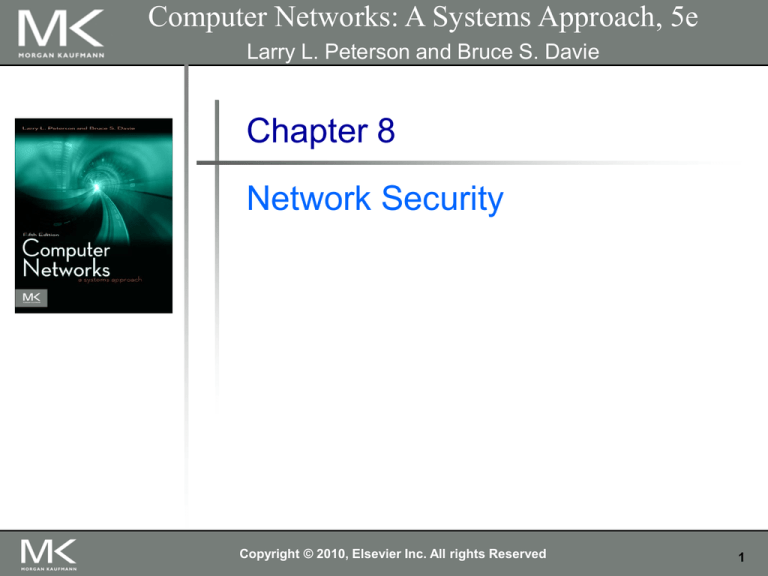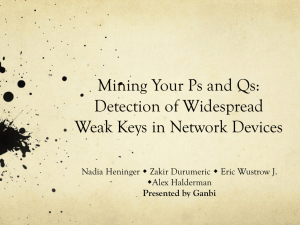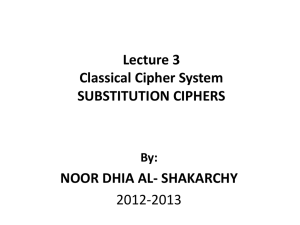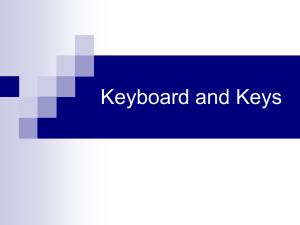
Computer Networks: A Systems Approach, 5e
Larry L. Peterson and Bruce S. Davie
Chapter 8
Network Security
Copyright © 2010, Elsevier Inc. All rights Reserved
1
Chapter 8
Problem
Computer networks are typically a shared
resource used by many applications
representing different interests.
The Internet is particularly widely shared, being
used by competing businesses, mutually
antagonistic governments, and opportunistic
criminals.
Unless security measures are taken, a network
conversation or a distributed application may be
compromised by an adversary.
2
Chapter 8
Problem
Consider some threats to secure use of, for
example, the World Wide Web.
Suppose you are a customer using a credit card to
order an item from a website.
An obvious threat is that an adversary would eavesdrop on
your network communication, reading your messages to
obtain your credit card information.
It is possible and practical, however, to encrypt messages so
as to prevent an adversary from understanding the message
contents. A protocol that does so is said to provide
confidentiality.
Taking the concept a step farther, concealing the quantity or
destination of communication is called traffic confidentiality
3
Even with confidentiality there still remain threats
for the website customer.
Chapter 8
Problem
An adversary who can’t read the contents of your
encrypted message might still be able to change a few
bits in it, resulting in a valid order for, say, a
completely different item or perhaps 1000 units of the
item.
There are techniques to detect, if not prevent, such
tampering.
A protocol that detects such message tampering
provides data integrity.
The adversary could alternatively transmit an extra
copy of your message in a replay attack.
4
To the website, it would appear as though you had
simply ordered another of the same item you ordered
the first time.
Chapter 8
Problem
A protocol that detects replays provides originality.
Originality would not, however, preclude the adversary
intercepting your order, waiting a while, then transmitting it—
in effect, delaying your order.
The adversary could thereby arrange for the item to arrive on
your doorstep while you are away on vacation, when it can be
easily snatched. A protocol that detects such delaying tactics
is said to provide timeliness.
Data integrity, originality, and timeliness are
considered aspects of the more general property of
integrity.
5
Chapter 8
Problem
Another threat to the customer is unknowingly being
directed to a false website.
This can result from a DNS attack, in which false information is
entered in a Domain Name Server or the name service cache of
the customer’s computer.
This leads to translating a correct URL into an incorrect IP
address—the address of a false website.
A protocol that ensures that you really are talking to whom you
think you’re talking is said to provide authentication.
Authentication entails integrity since it is meaningless to say that
a message came from a certain participant if it is no longer the
same message.
6
Chapter 8
Problem
The owner of the website can be attacked as well. Some
websites have been defaced; the files that make up the
website content have been remotely accessed and
modified without authorization.
That is an issue of access control: enforcing the rules
regarding who is allowed to do what. Websites have also
been subject to Denial of Service (DoS) attacks, during
which would-be customers are unable to access the
website because it is being overwhelmed by bogus
requests.
Ensuring a degree of access is called availability.
7
Chapter 8
Problem
In addition to these issues, the Internet has notably been
used as a means for deploying malicious code that
exploits vulnerabilities in end-systems.
Worms, pieces of self-replicating code that spread over
networks, have been known for several decades and
continue to cause problems, as do their relatives,
viruses, which are spread by the transmission of
“infected” files.
Infected machines can then be arranged into botnets
which can be used to inflict further harm, such as
launching DoS attacks.
8
Chapter 8
Chapter Outline
Cryptographic Building Blocks
Key Pre Distribution
Authentication Protocols
Example Systems
Firewalls
9
Chapter 8
Cryptograhic Building Blocks
We introduce the concepts of cryptography-based
security step by step.
The first step is the cryptographic algorithms—ciphers
and cryptographic hashes
Cryptographic algorithms are parameterized by keys
10
Chapter 8
Cryptograhic Building Blocks
Symmetric-key encryption and
decryption
11
Chapter 8
Cryptograhic Building Blocks
Principles of Ciphers
Encryption transforms a message in such a way that it
becomes unintelligible to any party that does not have
the secret of how to reverse the transformation.
The sender applies an encryption function to the
original plaintext message, resulting in a ciphertext
message that is sent over the network.
The receiver applies a secret decryption function–the
inverse of the encryption function–to recover the
original plaintext.
12
Chapter 8
Cryptograhic Building Blocks
Principles of Ciphers
The ciphertext transmitted across the network is
unintelligible to any eavesdropper, assuming she
doesn’t know the decryption function.
The transformation represented by an encryption
function and its corresponding decryption function is
called a cipher.
The basic requirement for an encryption algorithm is
that it turn plaintext into ciphertext in such a way that
only the intended recipient—the holder of the
decryption key—can recover the plaintext.
13
Chapter 8
Cryptograhic Building Blocks
Principles of Ciphers
It is important to realize that when a potential attacker
receives a piece of ciphertext, he may have more
information at his disposal than just the ciphertext
itself.
Known plaintext attack
Ciphetext only attack
Chosen plaintext attack
14
Chapter 8
Cryptograhic Building Blocks
Principles of Ciphers
Most ciphers are block ciphers: they are defined to
take as input a plaintext block of a certain fixed size,
typically 64 to 128 bits.
Using a block cipher to encrypt each block
independently—known as electronic codebook (ECB)
mode encryption—has the weakness that a given
plaintext block value will always result in the same
ciphertext block.
Hence recurring block values in the plaintext are
recognizable as such in the ciphertext, making it much
easier for a cryptanalyst to break the cipher.
15
Chapter 8
Cryptograhic Building Blocks
Principles of Ciphers
Block ciphers are always augmented to make
the ciphertext for a block vary depending on
context. Ways in which a block cipher may be
augmented are called modes of operation.
16
Chapter 8
Cryptograhic Building Blocks
Block Ciphers
A common mode of operation is cipher block
chaining (CBC), in which each plaintext block
is XORed with the previous block’s ciphertext
before being encrypted.
The result is that each block’s ciphertext depends
in part on the preceding blocks, i.e. on its context.
Since the first plaintext block has no preceding
block, it is XORed with a random number.
That random number, called an initialization vector (IV), is
included with the series of ciphertext blocks so that the
first ciphertext block can be decrypted.
17
Chapter 8
Cryptograhic Building Blocks
Block Ciphers
Cipher block chaining (CBC).
18
Chapter 8
Cryptograhic Building Blocks
Symmetric Key Ciphers
In a symmetric-key cipher, both participants in a
communication share the same key. In other words, if
a message is encrypted using a particular key, the
same key is required for decrypting the message.
19
Chapter 8
Cryptograhic Building Blocks
Symmetric Key Ciphers
The U.S. National Institute of Standards and
Technology (NIST) has issued standards for a series
of symmetric-key ciphers.
Data Encryption Standard (DES) was the first, and it
has stood the test of time in that no cryptanalytic
attack better than brute force search has been
discovered.
Brute force search, however, has gotten faster. DES’s
keys (56 independent bits) are now too small given
current processor speeds.
20
Chapter 8
Cryptograhic Building Blocks
Symmetric Key Ciphers
NIST also standardized the cipher Triple DES (3DES),
which leverages the cryptanalysis resistance of DES
while in effect increasing the key size.
A 3DES key has 168 (= 3256) independent bits, and
is used as three DES keys;
let’s call them DES-key1, DES-key2, and DES-key3.
3DES-encryption of a block is performed by first DESencrypting the block using DES-key1, then DES-decrypting
the result using DES-key2, and finally DES-encrypting that
result using DES-key3.
Decryption involves decrypting using DES-key3, then
encrypting using DES-key2, then decrypting using DES-key1
21
Chapter 8
Cryptograhic Building Blocks
Symmetric Key Ciphers
3DES is being superseded by the Advanced
Encryption Standard (AES) standard issued by NIST
in 2001.
The cipher selected to become that standard (with a
few minor modifications) was originally named
Rijndael (pronounced roughly like “Rhine dahl”) based
on the names of its inventors, Daemen and Rijmen.
AES supports key lengths of 128, 192, or 256 bits,
and the block length is 128 bits.
22
Chapter 8
Cryptograhic Building Blocks
Public Key Ciphers
An alternative to symmetric-key ciphers is
asymmetric, or public-key, ciphers.
Instead of a single key shared by two participants, a
public-key cipher uses a pair of related keys, one for
encryption and a different one for decryption.
The pair of keys is “owned” by just one participant.
The owner keeps the decryption key secret so that
only the owner can decrypt messages; that key is
called the private key.
23
Chapter 8
Cryptograhic Building Blocks
Public Key Ciphers
The owner makes the encryption key public, so that
anyone can encrypt messages for the owner; that key
is called the public key.
Obviously, for such a scheme to work it must not be
possible to deduce the private key from the public key.
Consequently any participant can get the public key
and send an encrypted message to the owner of the
keys, and only the owner has the private key
necessary to decrypt it.
24
Chapter 8
Cryptograhic Building Blocks
Public Key Ciphers
Public-key encryption
25
Chapter 8
Cryptograhic Building Blocks
Public Key Ciphers
An important additional property of public-key ciphers
is that the private “decryption” key can be used with
the encryption algorithm to encrypt messages so that
they can only be decrypted using the public
“encryption” key.
This property clearly wouldn’t be useful for
confidentiality since anyone with the public key could
decrypt such a message.
This property is, however, useful for authentication
since it tells the receiver of such a message that it
could only have been created by the owner of the
keys.
26
Chapter 8
Cryptograhic Building Blocks
Public Key Ciphers
Authentication using public keys
27
Chapter 8
Cryptograhic Building Blocks
Public Key Ciphers
The concept of public-key ciphers was first published
in 1976 by Diffie and Hellman.
The best-known public-key cipher is RSA, named
after its inventors: Rivest, Shamir, and Adleman.
RSA relies on the high computational cost of factoring large
numbers.
Another public-key cipher is ElGamal.
Like RSA, it relies on a mathematical problem, the discrete
logarithm problem, for which no efficient solution has been
found, and requires keys of at least 1024 bits.
28
Chapter 8
Cryptograhic Building Blocks
Authenticator
An authenticator is a value, to be included in a
transmitted message, that can be used to verify
simultaneously the authenticity and the data integrity
of a message.
One kind of authenticator combines encryption and a
cryptographic hash function.
Cryptographic hash algorithms are treated as public
knowledge, as with cipher algorithms.
A cryptographic hash function (also known as a cryptographic
checksum) is a function that outputs sufficient redundant
information about a message to expose any tampering.
29
Chapter 8
Cryptograhic Building Blocks
Authenticator
Just as a checksum or CRC exposes bit errors
introduced by noisy links, a cryptographic checksum is
designed to expose deliberate corruption of messages
by an adversary.
The value it outputs is called a message digest and, like an
ordinary checksum, is appended to the message.
All the message digests produced by a given hash have the
same number of bits regardless of the length of the original
message.
Since the space of possible input messages is larger than the
space of possible message digests, there will be different
input messages that produce the same message digest, like
collisions in a hash table.
30
Chapter 8
Cryptograhic Building Blocks
Authenticator
There are several common cryptographic hash
algorithms, including MD5 (for Message Digest 5) and
Secure Hash Algorithm 1 (SHA-1). MD5 outputs a
128-bit digest, and SHA-1 outputs a 160-bit digest
A digest encrypted with a public key algorithm but
using the private key is called a digital signature
because it provides nonrepudiation like a written
signature.
31
Chapter 8
Cryptograhic Building Blocks
Authenticator
Another kind of authenticator is similar, but instead of
encrypting a hash, it uses a hash-like function that
takes a secret value (known to only the sender and
the receiver) as a parameter.
Such a function outputs an authenticator called a
message authentication code (MAC).
The sender appends the MAC to her plaintext
message.
The receiver recomputes the MAC using the plaintext
and the secret value, and compares that recomputed
MAC to the received MAC.
32
Chapter 8
Cryptograhic Building Blocks
Authenticator
A common variation on MACs is to apply a
cryptographic hash (such as MD5 or SHA-1) to the
concatenation of the plaintext message and the secret
value.
The resulting digest is called a hashed message
authentication code (HMAC) since it is essentially a
MAC.
The HMAC, but not the secret value, is appended to
the plaintext message.
Only a receiver who knows the secret value can
compute the correct HMAC to compare with the
received HMAC.
33
Chapter 8
Cryptograhic Building Blocks
Authenticator
Computing a MAC versus computing
an HMAC
34
Chapter 8
Key Pre Distribution
To use ciphers and authenticators, the
communicating participants need to know what
keys to use.
In the case of a symmetric-key cipher, how does
a pair of participants obtain the key they share?
In the case of a public-key cipher, how do
participants know what public key belongs to a
certain participant?
The answer differs depending on whether the
keys are short-lived session keys or longer-lived
pre-distributed keys.
35
A session key is a key used to secure a single,
relatively short episode of communication: a
session.
Chapter 8
Key Pre Distribution
Each distinct session between a pair of participants
uses a new session key, which is always a symmetrickey key for speed.
The participants determine what session key to use by
means of a protocol—a session key establishment
protocol.
A session key establishment protocol needs its own
security (so that, for example, an adversary cannot
learn the new session key); that security is based on
the longer-lived pre-distributed keys.
36
Chapter 8
Key Pre Distribution
There are several motivations for this division of
labor between session keys and pre-distributed
keys:
Limiting the amount of time a key is used results in
less time for computationally intensive attacks, less
ciphertext for cryptanalysis, and less information
exposed should the key be broken.
Pre-distribution of symmetric keys is problematic.
Public key ciphers are generally superior for
authentication and session key establishment but too
slow to use encrypting entire messages for
confidentiality.
37
Chapter 8
Key Pre Distribution
Pre-Distribution of Public Keys
The algorithms to generate a matched pair of public
and private keys are publicly known, and software that
does it is widely available.
So if Alice wanted to use a public key cipher, she
could generate her own pair of public and private
keys, keep the private key hidden, and publicize the
public key.
But how can she publicize her public key— assert that
it belongs to her—in such a way that other participants
can be sure it really belongs to her?
38
Chapter 8
Key Pre Distribution
Pre-Distribution of Public Keys
A complete scheme for certifying bindings between
public keys and identities— what key belongs to
who—is called a Public Key Infrastructure (PKI).
A PKI starts with the ability to verify identities and bind
them to keys out of band. By “out of band,” we mean
something outside the network and the computers that
comprise it, such as in the following scenarios.
If Alice and Bob are individuals who know each other,
then they could get together in the same room and
Alice could give her public key to Bob directly,
perhaps on a business card.
39
Chapter 8
Key Pre Distribution
Pre-Distribution of Public Keys
If Bob is an organization, Alice the individual could
present conventional identification, perhaps involving
a photograph or fingerprints.
If Alice and Bob are computers owned by the same
company, then a system administrator could configure
Bob with Alice’s public key.
A digitally signed statement of a public key binding is
called a public key certificate, or simply a certificate
40
Chapter 8
Key Pre Distribution
Pre-Distribution of Public Keys
One of the major standards for certificates is known
as X.509. This standard leaves a lot of details open,
but specifies a basic structure. A certificate clearly
must include
the identity of the entity being certified
the public key of the entity being certified
the identity of the signer
the digital signature
a digital signature algorithm identifier (which cryptographic
hash and which cipher)
41
Chapter 8
Key Pre Distribution
Pre-Distribution of Public Keys
Certification Authorities
A certification authority or certificate authority (CA) is an entity
claimed (by someone) to be trustworthy for verifying identities
and issuing public key certificates.
There are commercial CAs, governmental CAs, and even free
CAs.
To use a CA, you must know its own key. You can learn that
CA’s key, however, if you can obtain a chain of CA-signed
certificates that starts with a CA whose key you already know.
Then you can believe any certificate signed by that new CA
42
Chapter 8
Key Pre Distribution
Pre-Distribution of Symmetric Keys
If Alice wants to use a secret-key cipher to communicate with
Bob, she can’t just pick a key and send it to to him because,
without already having a key, they can’t encrypt this key to keep
it confidential and they can’t authenticate each other.
As with public keys, some pre-distribution scheme is needed.
Pre-distribution is harder for symmetric keys than for public keys
for two obvious reasons:
While only one public key per entity is sufficient for authentication and
confidentiality, there must be a symmetric key for each pair of entities who
wish to communicate. If there are N entities, that means N(N − 1)/2 keys.
Unlike public keys, secret keys must be kept secret.
43
Chapter 8
Key Pre Distribution
Pre-Distribution of Symmetric Keys
Authentication Protocols
A challenge-response protocol
44
Chapter 8
Key Pre Distribution
Pre-Distribution of Symmetric Keys
Public Key Authentication Protocols
A public-key authentication protocol
that depends on synchronization
45
Chapter 8
Key Pre Distribution
Pre-Distribution of Symmetric Keys
Public Key Authentication Protocols
A public-key authentication protocol that does not depend on synchronization.
Alice checks her own timestamp against her own clock, and likewise for Bob.
46
Chapter 8
Key Pre Distribution
Pre-Distribution of Symmetric Keys
Symmetric Key Authentication Protocols
The Needham-Schroeder authentication protocol
47
Chapter 8
Key Pre Distribution
Pre-Distribution of Symmetric Keys
Symmetric Key Authentication Protocols
Kerberos Authentication
48
Chapter 8
Key Pre Distribution
Pre-Distribution of Symmetric Keys
Diffie-Hellman Key Agreement
The Diffie-Hellman key agreement protocol establishes a session
key without using any pre-distributed keys.
The messages exchanged between Alice and Bob can be read by
anyone able to eavesdrop, and yet the eavesdropper won’t know the
session key that Alice and Bob end up with.
On the other hand, Diffie-Hellman doesn’t authenticate the
participants.
Since it is rarely useful to communicate securely without being sure
whom you’re communicating with, Diffie-Hellman is usually
augmented in some way to provide authentication.
One of the main uses of Diffie-Hellman is in the Internet Key
Exchange (IKE) protocol, a central part of the IP Security (IPSEC)
architecture
49
Chapter 8
Key Pre Distribution
Pre-Distribution of Symmetric Keys
Diffie-Hellman Key Agreement
The Diffie-Hellman protocol has two parameters, p and g, both of
which are public and may be used by all the users in a particular
system.
Parameter p must be a prime number. The integers mod p (short for
modulo p) are 0 through p − 1, since x mod p is the remainder after
x is divided by p, and form what mathematicians call a group under
multiplication.
Parameter g (usually called a generator) must be a primitive root of
p: for every number n from 1 through p − 1 there must be some
value k such that n = gk mod p.
50
Chapter 8
Key Pre Distribution
Pre-Distribution of Symmetric Keys
Diffie-Hellman Key Agreement
For example, if p were the prime number 5 (a real system would use
a much larger number), then we might choose 2 to be the generator
g since:
1 = 20 mod p
2 = 21 mod p
3 = 23 mod p
4 = 22 mod p
51
Chapter 8
Key Pre Distribution
Pre-Distribution of Symmetric Keys
Diffie-Hellman Key Agreement
Suppose Alice and Bob want to agree on a shared symmetric key.
Alice and Bob, and everyone else, already know the values of p and
g.
Alice generates a random private value a and Bob generates a
random private value b.
Both a and b are drawn from the set of integers {1, ..., p−1}.
Alice and Bob derive their corresponding public values—the values
they will send to each other unencrypted—as follows.
Alice’s public value is ga mod p
and Bob’s public value is gb mod p
They then exchange their public values. Finally, Alice computes
gab mod p = (gb mod p)a mod p
and Bob computes
gba mod p = (ga mod p)b mod p.
52
Chapter 8
Key Pre Distribution
Pre-Distribution of Symmetric Keys
Diffie-Hellman Key Agreement
Alice and Bob derive their corresponding public values—the values
they will send to each other unencrypted—as follows.
Alice’s public value is ga mod p
and Bob’s public value is gb mod p
They then exchange their public values. Finally, Alice computes
gab mod p = (gb mod p)a mod p
and Bob computes
gba mod p = (ga mod p)b mod p.
53
Chapter 8
Key Pre Distribution
Pre-Distribution of Symmetric Keys
A man-in-the-middle attack
54
Chapter 8
Example Systems
Pretty Good Privacy (PGP)
Pretty Good Privacy (PGP) is a widely used approach to
providing security for electronic mail. It provides authentication,
confidentiality, data integrity, and nonrepudiation.
Originally devised by Phil Zimmerman, it has evolved into an
IETF standard known as OpenPGP
PGP’s confidentiality and receiver authentication depend on the
receiver of an email message having a public key that is known
to the sender.
To provide sender authentication and nonrepudiation, the sender
must have a public key that is known by the receiver.
These public keys are pre-distributed using certificates and a
web-of-trust PKI.
PGP supports RSA and DSS for public key certificates.
55
Chapter 8
Example Systems
Pretty Good Privacy (PGP)
PGP’s steps to prepare a message for
emailing from Alice to Bob
56
Chapter 8
Example Systems
Secure Shell (SSH)
The Secure Shell (SSH) protocol is used to provide a remote
login service, and is intended to replace the less-secure Telnet
and rlogin programs used in the early days of the Internet.
SSH is most often used to provide strong client/server
authentication/ message integrity—where the SSH client runs on
the user’s desktop machine and the SSH server runs on some
remote machine that the user wants to log into—but it also
supports confidentiality.
Telnet and rlogin provide none of these capabilities.
Note that “SSH” is often used to refer to both the SSH protocol
and applications that use it; you need to figure out which from the
context.
57
Chapter 8
Example Systems
Secure Shell (SSH)
Using SSH port forwarding to secure
other TCP-based applications
58
Chapter 8
Example Systems
Transport Layer Security (TLS, SSL, HTTPS)
Handshake protocol to establish TLS
session
59
Chapter 8
Example Systems
IP Security (IPSec)
Support for IPsec, as the architecture is called, is optional in IPv4
but mandatory in IPv6.
IPsec is really a framework (as opposed to a single protocol or
system) for providing all the security services discussed
throughout this chapter.
IPsec provides three degrees of freedom.
First, it is highly modular, allowing users (or more likely, system
administrators) to select from a variety of cryptographic algorithms and
specialized security protocols.
Second, IPsec allows users to select from a large menu of security
properties, including access control, integrity, authentication, originality, and
confidentiality.
Third, IPsec can be used to protect “narrow” streams (e.g., packets
belonging to a particular TCP connection being sent between a pair of hosts)
or “wide” streams (e.g., all packets flowing between a pair of routers).
60
Chapter 8
Example Systems
IP Security (IPSec)
When viewed from a high level, IPsec consists of two parts.
The first part is a pair of protocols that implement the available
security services.
They are the Authentication Header (AH), which provides access control,
connectionless message integrity, authentication, and antireplay protection,
and the Encapsulating Security Payload (ESP), which supports these same
services, plus confidentiality.
AH is rarely used so we focus on ESP here.
The second part is support for key management, which fits under
an umbrella protocol known as ISAKMP:
Internet Security Association and Key Management Protocol.
61
Chapter 8
Example Systems
IP Security (IPSec)
The abstraction that binds these two pieces together is the
security association (SA).
An SA is a simplex (one-way) connection with one or more of the
available security properties.
Securing a bidirectional communication between a pair of
hosts— corresponding to a TCP connection, for example—
requires two SAs, one in each direction.
Although IP is a connectionless protocol, security depends on
connection state information such as keys and sequence
numbers.
When created, an SA is assigned an ID number called a security
parameters index (SPI) by the receiving machine
62
Chapter 8
Example Systems
IP Security (IPSec)
IPsec supports a tunnel mode as well as the more
straightforward transport mode.
Each SA operates in one or the other mode.
In a transport mode SA, ESP’s payload data is simply a message
for a higher layer such as UDP or TCP.
In this mode, IPsec acts as an intermediate protocol layer, much like
SSL/TLS does between TCP and a higher layer.
When an ESP message is received, its payload is passed to the higher level
protocol.
In a tunnel mode SA, however, ESP’s payload data is itself an IP
packet
63
Chapter 8
Example Systems
IP Security (IPSec)
IPsec’s ESP format
64
Chapter 8
Example Systems
IP Security (IPSec)
An IP packet with a nested IP packet
encapsulated using ESP in tunnel
mode. Note that the inner and outer
packets have different addresses
65
Chapter 8
Example Systems
Wireless Security (IEEE 802.11i)
The IEEE 802.11i standard provides authentication, message
integrity, and confidentiality to 802.11 (Wi-Fi) at the link layer.
WPA2 (Wi-Fi Protected Access 2) is often used as a synonym for
802.11i, although it is technically a trademark of The Wi-Fi
Alliance that certifies product compliance with 802.11i.
802.11i authentication supports two modes. In either mode, the
end result of successful authentication is a shared Pairwise
Master Key.
Personal mode, also known as Pre-Shared Key (PSK) mode, provides
weaker security but is more convenient and economical for situations like a
home 802.11 network.
The wireless device and the Access Point (AP) are preconfigured with a
shared passphrase—essentially a very long password—from with the
Pairwise Master Key is cryptographically derived.
66
Chapter 8
Example Systems
Wireless Security (IEEE 802.11i)
Use of an Authentication Server in
802.11i
67
Chapter 8
Firewalls
A firewall is a system that typically sits at some point of
connectivity between a site it protects and the rest of the
network.
It is usually implemented as an “appliance” or part of a
router, although a “personal firewall” may be
implemented on an end user machine.
Firewall-based security depends on the firewall being the
only connectivity to the site from outside; there should be
no way to bypass the firewall via other gateways,
wireless connections, or dial-up connections.
68
Chapter 8
Firewalls
In effect, a firewall divides a network into a more-trusted
zone internal to the firewall, and a less-trusted zone
external to the firewall.
This is useful if you do not want external users to access
a particular host or service within your site.
Firewalls may be used to create multiple zones of trust,
such as a hierarchy of increasingly trusted zones.
A common arrangement involves three zones of trust: the
internal network; the DMZ (“demilitarized zone”); and the
rest of the Internet.
69
Chapter 8
Firewalls
Firewalls filter based on IP, TCP, and UDP information,
among other things.
They are configured with a table of addresses that
characterize the packets they will, and will not, forward.
By addresses, we mean more than just the destination’s
IP address, although that is one possibility.
Generally, each entry in the table is a 4-tuple: It gives the
IP address and TCP (or UDP) port number for both the
source and destination.
70
Chapter 8
Firewalls
A firewall filters packets flowing
between a site and the rest of the
Internet
71
We have discussed privacy and security issues in the
network
We have discussed different authentication protocols
We have discussed different key distribution protocols
We have discussed different cipher techniques
Chapter 8
Summary
Classical and Public-Key
We have discussed some examples of secured systems
PGP, SSH, IPSec
72









